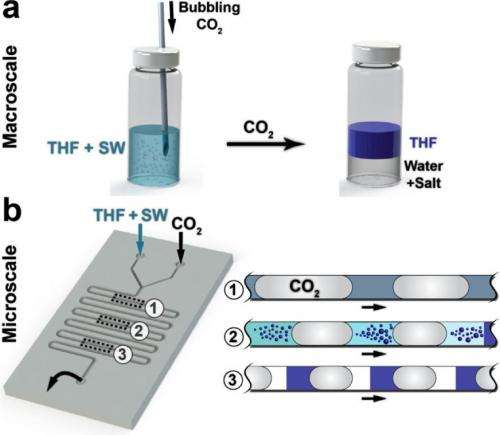August 26, 2014 feature
New insights into 'switchable water' have implications for water purification and desalination

(Phys.org) —Water is rarely pure; instead, it often contains dissolved ions or is mixed with other liquids. Scientists can change the composition of water by separating its mixtures, which is most commonly performed by distillation. However, distillation is an energy-intensive process.
Over the past few years, researchers at Queen University in Canada have discovered an alternative, much simpler method of changing the properties of water by mixing it with a nitrogen-based compound and adding or removing gaseous carbon dioxide to the system.
Because of the reversible reaction of carbon dioxide and a nitrogen-containing compound, the ionic strength of water can be reversibly switched: the ionic strength increases upon insertion of carbon dioxide in the liquid, and decreases with its removal. If water were originally mixed with an organic solvent, an increasing ionic strength of water would cause the mixture to separate into two different liquid phases, which are typically separated by a membrane. In principle, other "switchable solvents" would exhibit carbon-dioxide-mediated changes in hydrophilicity, polarity, fluorescence properties, or viscosity.
Switchable solvents are still a very new area, however, and there is much that remains unknown. For example, it would be very helpful to know the rate of the phase-separation process in switchable water systems, the optimal CO2 concentration, and the efficiency of nitrogenous bases for liquid-liquid phase separation.
In a new paper published in the Journal of the American Chemical Society, a team of researchers including Gabriella Lestari and Milad Abolhasani, led by Prof. Eugenia Kumacheva at the University of Toronto, have turned to a new tool called microfluidics to explore liquid-liquid phase separation in an efficient way. Although microfluidics strategies have previously been used to study CO2-related processes in liquid solvents, this is the first time that microfluidics has been applied to studies of liquid-liquid phase separation mediated by water switching.
"This work could definitely help to develop and optimize switchable solvents for many important applications, such as desalination of water by forward osmosis or as an alternative for the salting out process in pharmaceutical applications," Kumacheva told Phys.org. "In addition, our microfluidic strategy could be adapted to study other phenomena induced by water switching, such as the synthesis and functionalization of nanoparticles."
The microfluidics approach allowed the researchers to take a more in-depth look at the water switching process. The particular process they analyzed begins with the introduction of CO2 bubbles into a solution of water containing a nitrogenous base (for example, amines) that is mixed with a second solvent (for example, tetrahydrofuran [THF]). While moving along the flow direction, the CO2 bubbles react with the amines, causing the system to phase-separate into two distinct phases, THF and an aqueous amine solution. By removing the CO2 by heating and/or purging another gas (e.g., nitrogen), the original liquid can be recovered. The amine additive can also be removed from the solution as a gas, leaving behind purified water.
That much can be observed in macroscale experiments, but here the scientists were able to investigate this reaction on the microscale, allowing them to obtain a lot of information from only a single experiment. They evaluated the rate of phase separation process, calculated the minimum amount of CO2 required to complete the phase separation, identified the most efficient type of amine, and determined the efficiency of the phase separation. These results would be very difficult, if not impossible, to obtain using macroscale characterization techniques.
Applying the liquid-liquid phase separation process to different solutions could have a variety of applications, including water desalination and purification. The results of this study could be used to characterize and improve the efficiency of these processes by facilitating the rapid exploration, development and optimization of new additives. Microfluidics strategies could be further extended to investigate the effects of temperatures, pressures, and compositions on water switching.
"We plan to extend our microfluidic strategy to explore other switchable solvents with a broad range of switchable properties, as well as discover new applications of switchable solvents in a microfluidic format," Kumacheva said. "In general, the applications of microfluidics in studies of carbon dioxide, a very important greenhouse gas, are just beginning to evolve."
More information: Gabriella Lestari, et al. "Switchable Water: Microfluidic Investigation of Liquid-Liquid Phase Separation Mediated by Carbon Dioxide." Journal of the American Chemical Society. DOI: 10.1021/ja504184q
M. Abolhasani, et al. "Microfluidic Studies of Carbon Dioxide." Angew. Chem. DOI: 10.1002/ange.201403719
Journal information: Journal of the American Chemical Society
© 2014 Phys.org



















